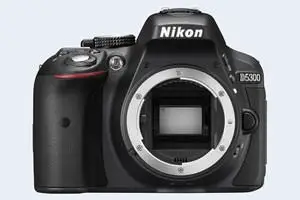Canon G3 X vs Nikon D5300
The Canon PowerShot G3 X and the Nikon D5300 are two digital cameras that were revealed to the public, respectively, in June 2015 and October 2013. The G3X is a fixed lens compact, while the D5300 is a DSLR. The cameras are based on an one-inch (G3X) and an APS-C (D5300) sensor. The Canon has a resolution of 20 megapixels, whereas the Nikon provides 24 MP.
Below is an overview of the main specs of the two cameras as a starting point for the comparison.

Check G3X offers at
ebay.com

Check D5300 offers at
ebay.com
Going beyond this snapshot of core features and characteristics, what are the differences between the Canon PowerShot G3 X and the Nikon D5300? Which one should you buy? Read on to find out how these two cameras compare with respect to their body size, their imaging sensors, their shooting features, their input-output connections, and their reception by expert reviewers.
Body comparison
The physical size and weight of the Canon G3 X and the Nikon D5300 are illustrated in the side-by-side display below. The two cameras are presented according to their relative size. Three successive views from the front, the top, and the rear are shown. All width, height and depth dimensions are rounded to the nearest millimeter.
The D5300 can be obtained in three different colors (black, grey, red), while the G3X is only available in black.
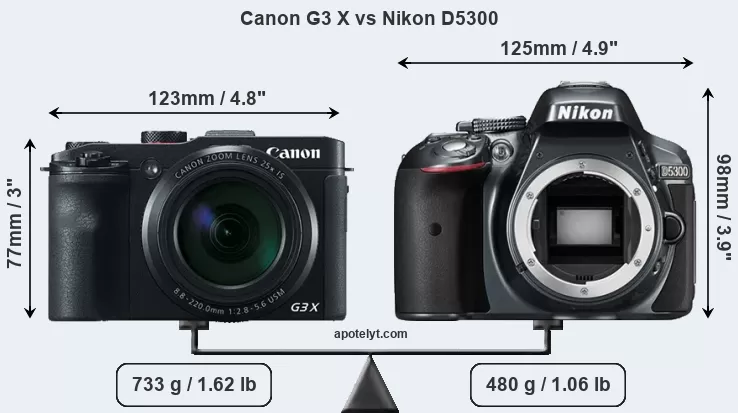
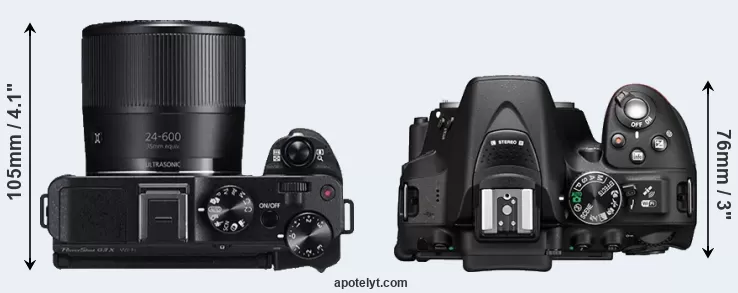
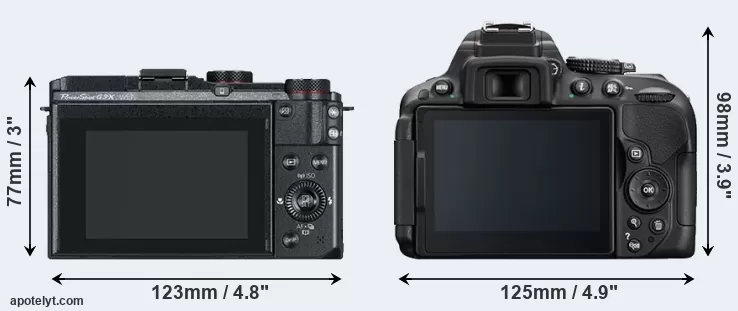
If the front view area (width x height) of the cameras is taken as an aggregate measure of their size, the Nikon D5300 is notably larger (29 percent) than the Canon G3 X. It is worth mentioning in this context that the G3X is splash and dust resistant, while the D5300 does not feature any corresponding weather-sealing.
The above size and weight comparisons are to some extent incomplete and possibly misleading, as the G3X has a lens built in, whereas the D5300 is an interchangeable lens camera that requires a separate lens. Attaching the latter will add extra weight and bulk to the setup. You can compare the optics available for the D5300 and their specifications in the Nikon Lens Catalog.
Concerning battery life, the G3X gets 300 shots out of its Canon NB-10L battery, while the D5300 can take 600 images on a single charge of its Nikon EN-EL14a power pack.
The adjacent table lists the principal physical characteristics of the two cameras alongside a wider set of alternatives. In case you want to display and compare another camera duo, you can use the CAM-parator app to select your camera combination among a large number of options.

| Camera Model |
Camera Width |
Camera Height |
Camera Depth |
Camera Weight |
Battery Life |
Weather Sealing |
Camera Launch |
Launch Price (USD) |
Street Price |
||
|---|---|---|---|---|---|---|---|---|---|---|---|
| 1. | Canon G3 X | 123 mm | 77 mm | 105 mm | 733 g | 300 | Y | Jun 2015 | 999 | ebay.com | |
| 2. | Nikon D5300 | 125 mm | 98 mm | 76 mm | 480 g | 600 | n | Oct 2013 | 799 | ebay.com | |
| 3. | Canon 7D II | 149 mm | 112 mm | 78 mm | 910 g | 670 | Y | Sep 2014 | 1,799 | ebay.com | |
| 4. | Canon 70D | 139 mm | 104 mm | 79 mm | 755 g | 920 | Y | Jul 2013 | 1,199 | ebay.com | |
| 5. | Canon 80D | 139 mm | 105 mm | 79 mm | 730 g | 960 | Y | Feb 2016 | 1,199 | ebay.com | |
| 6. | Canon G9 X | 98 mm | 58 mm | 31 mm | 209 g | 220 | n | Oct 2015 | 529 | ebay.com | |
| 7. | Nikon D3200 | 125 mm | 96 mm | 77 mm | 505 g | 540 | n | Apr 2012 | 599 | ebay.com | |
| 8. | Nikon D3300 | 124 mm | 98 mm | 76 mm | 430 g | 700 | n | Jan 2014 | 499 | ebay.com | |
| 9. | Nikon D5200 | 129 mm | 98 mm | 78 mm | 555 g | 500 | n | Nov 2012 | 749 | ebay.com | |
| 10. | Nikon D5500 | 124 mm | 97 mm | 70 mm | 470 g | 820 | n | Jan 2015 | 899 | ebay.com | |
| 11. | Nikon D5600 | 124 mm | 97 mm | 70 mm | 465 g | 970 | n | Nov 2016 | 699 | ebay.com | |
| 12. | Nikon D7200 | 136 mm | 107 mm | 76 mm | 765 g | 1110 | Y | Mar 2015 | 1,199 | ebay.com | |
| 13. | Panasonic FZ1000 | 137 mm | 99 mm | 131 mm | 831 g | 360 | n | Jun 2014 | 899 | ebay.com | |
| 14. | Sony RX10 II | 129 mm | 88 mm | 102 mm | 813 g | 400 | Y | Jun 2015 | 1,299 | ebay.com | |
| 15. | Sony RX10 III | 133 mm | 94 mm | 127 mm | 1051 g | 420 | Y | Mar 2016 | 1,499 | ebay.com | |
| 16. | Sony RX100 IV | 102 mm | 58 mm | 41 mm | 298 g | 280 | n | Jun 2015 | 999 | ebay.com | |
| 17. | Sony RX100 V | 102 mm | 58 mm | 41 mm | 299 g | 220 | n | Oct 2016 | 999 | ebay.com | |
| Note: Measurements and pricing do not include easily detachable parts, such as add-on or interchangeable lenses or optional viewfinders. | |||||||||||
Any camera decision will naturally be influenced heavily by the price. The retail prices at the time of the camera’s release place the model in the market relative to other models in the producer’s line-up and the competition. Usually, retail prices stay at first close to the launch price, but after several months, discounts become available. Later in the product cycle and, in particular, when the replacement model is about to appear, further discounting and stock clearance sales often push the camera price considerably down.
Sensor comparison
The size of the imaging sensor is a crucial determinant of image quality. A large sensor will tend to have larger individual pixels that provide better low-light sensitivity, wider dynamic range, and richer color-depth than smaller pixel-units in a sensor of the same technological generation. Further, a large sensor camera will give the photographer additional creative options when using shallow depth-of-field to isolate a subject from its background. On the downside, larger sensors tend to be associated with larger, more expensive camera bodies and lenses.
Of the two cameras under consideration, the Canon G3 X features an one-inch sensor and the Nikon D5300 an APS-C sensor. The sensor area in the D5300 is 216 percent bigger. As a result of these sensor size differences, the cameras have a format factor of, respectively, 2.7 and 1.5. Both cameras have a native aspect ratio (sensor width to sensor height) of 3:2.
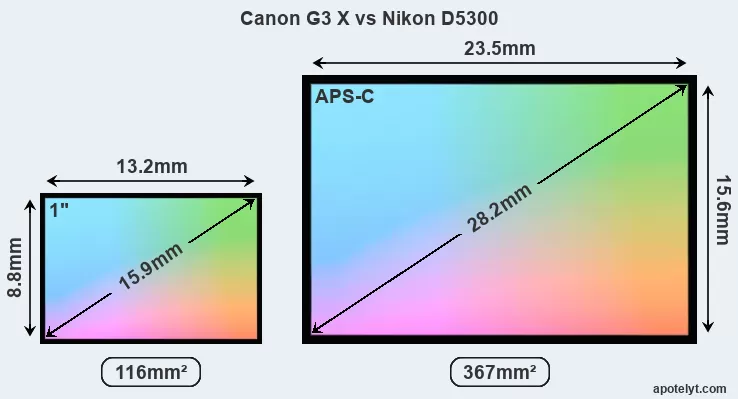
With 24MP, the D5300 offers a higher resolution than the G3X (20MP), but the D5300 nevertheless has larger individual pixels (pixel pitch of 3.91μm versus 2.41μm for the G3X) due to its larger sensor. However, the G3X is a somewhat more recent model (by 1 year and 8 months) than the D5300, and its sensor might have benefitted from technological advances during this time that enhance the light gathering capacity of its pixel-units. Coming back to sensor resolution, it should be mentioned that the D5300 has no anti-alias filter installed, so that it can capture all the detail its sensor resolves.
The resolution advantage of the Nikon D5300 implies greater flexibility for cropping images or the possibility to print larger pictures. The maximum print size of the D5300 for good quality output (200 dots per inch) amounts to 30 x 20 inches or 76.2 x 50.8 cm, for very good quality (250 dpi) 24 x 16 inches or 61 x 40.6 cm, and for excellent quality (300 dpi) 20 x 13.3 inches or 50.8 x 33.9 cm. The corresponding values for the Canon G3 X are 27.4 x 18.2 inches or 69.5 x 46.3 cm for good quality, 21.9 x 14.6 inches or 55.6 x 37.1 cm for very good quality, and 18.2 x 12.2 inches or 46.3 x 30.9 cm for excellent quality prints.
The Canon PowerShot G3 X has a native sensitivity range from ISO 125 to ISO 12800, which can be extended to ISO 125-25600. The corresponding ISO settings for the Nikon D5300 are ISO 100 to ISO 12800, with the possibility to increase the ISO range to 100-25600.
In terms of underlying technology, the G3X is build around a BSI-CMOS sensor, while the D5300 uses a CMOS imager. Both cameras use a Bayer filter for capturing RGB colors on a square grid of photosensors. This arrangement is found in most digital cameras.
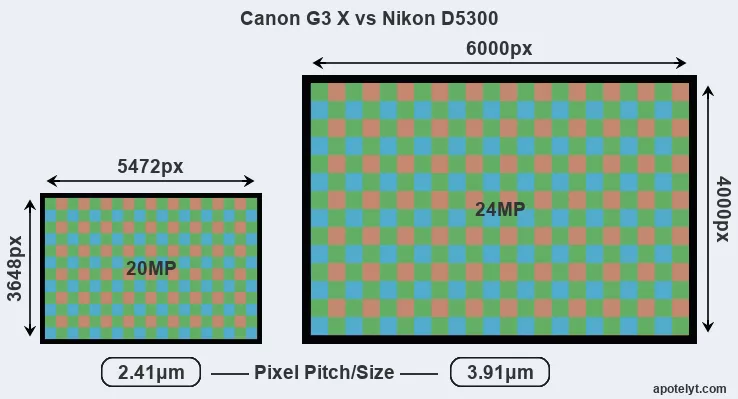
Since 2007, DXO Mark has published sensor performance measurements that have been derived using a consistent methodology. This service determines an overall sensor rating, as well as sub-scores for low-light sensitivity ("DXO Sports"), dynamic range ("DXO Landscape"), and color depth ("DXO Portrait"). Of the two cameras under consideration, the D5300 offers substantially better image quality than the G3X (overall score 20 points higher). The advantage is based on 2.6 bits higher color depth, 1.6 EV in additional dynamic range, and 1.4 stops in additional low light sensitivity. The following table provides an overview of the physical sensor characteristics, as well as the sensor quality measurements for a selection of comparators.

| Camera Model |
Sensor Class |
Resolution (MP) |
Horiz. Pixels |
Vert. Pixels |
Video Format |
DXO Portrait |
DXO Landscape |
DXO Sports |
DXO Overall |
||
|---|---|---|---|---|---|---|---|---|---|---|---|
| 1. | Canon G3 X | 1-inch | 20.0 | 5472 | 3648 | 1080/60p | 21.4 | 12.3 | 521 | 63 | |
| 2. | Nikon D5300 | APS-C | 24.0 | 6000 | 4000 | 1080/60p | 24.0 | 13.9 | 1338 | 83 | |
| 3. | Canon 7D II | APS-C | 20.0 | 5472 | 3648 | 1080/60p | 22.4 | 11.8 | 1082 | 70 | |
| 4. | Canon 70D | APS-C | 20.0 | 5472 | 3648 | 1080/30p | 22.5 | 11.6 | 926 | 68 | |
| 5. | Canon 80D | APS-C | 24.0 | 6000 | 4000 | 1080/60p | 23.6 | 13.2 | 1135 | 79 | |
| 6. | Canon G9 X | 1-inch | 20.0 | 5472 | 3648 | 1080/60p | 21.5 | 12.3 | 495 | 63 | |
| 7. | Nikon D3200 | APS-C | 24.1 | 6016 | 4000 | 1080/30p | 24.1 | 13.2 | 1131 | 81 | |
| 8. | Nikon D3300 | APS-C | 24.0 | 6000 | 4000 | 1080/60p | 24.3 | 12.8 | 1385 | 82 | |
| 9. | Nikon D5200 | APS-C | 24.0 | 6000 | 4000 | 1080/60i | 24.2 | 13.9 | 1284 | 84 | |
| 10. | Nikon D5500 | APS-C | 24.0 | 6000 | 4000 | 1080/60p | 24.1 | 14.0 | 1438 | 84 | |
| 11. | Nikon D5600 | APS-C | 24.0 | 6000 | 4000 | 1080/60p | 24.1 | 14.0 | 1306 | 84 | |
| 12. | Nikon D7200 | APS-C | 24.0 | 6000 | 4000 | 1080/60p | 24.5 | 14.6 | 1333 | 87 | |
| 13. | Panasonic FZ1000 | 1-inch | 20.0 | 5472 | 3648 | 4K/30p | 22.1 | 11.7 | 517 | 64 | |
| 14. | Sony RX10 II | 1-inch | 20.0 | 5472 | 3648 | 4K/30p | 23.0 | 12.6 | 531 | 70 | |
| 15. | Sony RX10 III | 1-inch | 20.0 | 5472 | 3648 | 4K/30p | 23.1 | 12.6 | 472 | 70 | |
| 16. | Sony RX100 IV | 1-inch | 20.0 | 5472 | 3648 | 4K/30p | 22.8 | 12.6 | 591 | 70 | |
| 17. | Sony RX100 V | 1-inch | 20.0 | 5472 | 3648 | 4K/30p | 22.8 | 12.4 | 586 | 70 |
Many modern cameras are not only capable of taking still images, but also of capturing video footage. Both cameras under consideration have a sensor with sufficiently fast read-out times for moving pictures, and both provide the same movie specifications (1080/60p).
Feature comparison
Beyond body and sensor, cameras can and do differ across a range of features. For example, the D5300 has an optical viewfinder, which can be very useful when shooting in bright sunlight. In contrast, the G3X relies on live view and the rear LCD for framing. That said, the G3X can be equipped with an optional viewfinder – the EVF-DC1. The adjacent table lists some of the other core features of the Canon G3 X and Nikon D5300 along with similar information for a selection of comparators.

| Camera Model |
Viewfinder (Type or 000 dots) |
Control Panel (yes/no) |
LCD Specifications (inch/000 dots) |
LCD Attach- ment |
Touch Screen (yes/no) |
Max Shutter Speed * |
Max Shutter Flaps * |
Built-in Flash (yes/no) |
Built-in Image Stab |
||
|---|---|---|---|---|---|---|---|---|---|---|---|
| 1. | Canon G3 X | optional | n | 3.2 / 1620 | tilting | Y | 1/2000s | 5.9/s | Y | Y | |
| 2. | Nikon D5300 | optical | n | 3.2 / 1037 | swivel | n | 1/4000s | 5.0/s | Y | n | |
| 3. | Canon 7D II | optical | Y | 3.0 / 1040 | fixed | n | 1/8000s | 10.0/s | Y | n | |
| 4. | Canon 70D | optical | Y | 3.0 / 1040 | swivel | Y | 1/8000s | 7.0/s | Y | n | |
| 5. | Canon 80D | optical | Y | 3.0 / 1040 | swivel | Y | 1/8000s | 7.0/s | Y | n | |
| 6. | Canon G9 X | none | n | 3.0 / 1040 | fixed | Y | 1/2000s | 6.0/s | Y | Y | |
| 7. | Nikon D3200 | optical | n | 3.0 / 921 | fixed | n | 1/4000s | 4.0/s | Y | n | |
| 8. | Nikon D3300 | optical | n | 3.0 / 921 | fixed | n | 1/4000s | 5.0/s | Y | n | |
| 9. | Nikon D5200 | optical | n | 3.0 / 921 | swivel | n | 1/4000s | 5.0/s | Y | n | |
| 10. | Nikon D5500 | optical | n | 3.2 / 1037 | swivel | Y | 1/4000s | 5.0/s | Y | n | |
| 11. | Nikon D5600 | optical | n | 3.2 / 1037 | swivel | Y | 1/4000s | 5.0/s | Y | n | |
| 12. | Nikon D7200 | optical | Y | 3.2 / 1229 | fixed | n | 1/8000s | 6.0/s | Y | n | |
| 13. | Panasonic FZ1000 | 2359 | n | 3.0 / 921 | swivel | n | 1/4000s | 12.0/s | Y | Y | |
| 14. | Sony RX10 II | 2359 | Y | 3.0 / 1229 | tilting | n | 1/3200s | 14.0/s | Y | Y | |
| 15. | Sony RX10 III | 2359 | Y | 3.0 / 1229 | tilting | n | 1/2000s | 14.0/s | Y | Y | |
| 16. | Sony RX100 IV | 2359 | n | 3.0 / 1228 | tilting | n | 1/2000s | 16.0/s | Y | Y | |
| 17. | Sony RX100 V | 2359 | n | 3.0 / 1229 | tilting | n | 1/2000s | 24.0/s | Y | Y | |
| Note: *) Information refers to the mechanical shutter, unless the camera only has an electronic one. | |||||||||||
One differentiating feature between the two cameras concerns the touch sensitivity of the rear screen. The G3X has a touchscreen, while the D5300 has a conventional panel. Touch control can be particularly helpful, for example, for setting the focus point.
Both cameras have an articulated rear screen that can be turned to be front-facing. This feature will be particularly appreciated by vloggers and photographers who are interested in taking selfies.The Nikon D5300 has an intervalometer built-in. This enables the photographer to capture time lapse sequences, such as flower blooming, a sunset or moon rise, without purchasing an external camera trigger and related software.
Concerning the storage of imaging data, both the G3X and the D5300 write their files to SDXC cards. Both cameras can use UHS-I cards, which provide for Ultra High Speed data transfer of up to 104 MB/s.
Connectivity comparison
For some imaging applications, the extent to which a camera can communicate with its environment can be an important aspect in the camera decision process. The table below provides an overview of the connectivity of the Canon PowerShot G3 X and Nikon D5300 and, in particular, the interfaces the cameras (and selected comparators) provide for accessory control and data transfer.

| Camera Model |
Hotshoe Port |
Internal Mic / Speaker |
Microphone Port |
Headphone Port |
HDMI Port |
USB Port |
WiFi Support |
NFC Support |
Bluetooth Support |
||
|---|---|---|---|---|---|---|---|---|---|---|---|
| 1. | Canon G3 X | Y | stereo / mono | Y | Y | mini | 2.0 | Y | Y | - | |
| 2. | Nikon D5300 | Y | stereo / mono | Y | - | mini | 2.0 | Y | - | - | |
| 3. | Canon 7D II | Y | stereo / mono | Y | Y | mini | 3.0 | - | - | - | |
| 4. | Canon 70D | Y | stereo / mono | Y | - | mini | 2.0 | Y | - | - | |
| 5. | Canon 80D | Y | stereo / mono | Y | Y | mini | 2.0 | Y | Y | - | |
| 6. | Canon G9 X | - | stereo / mono | - | - | micro | 2.0 | Y | Y | - | |
| 7. | Nikon D3200 | Y | mono / mono | Y | - | mini | 2.0 | - | - | - | |
| 8. | Nikon D3300 | Y | mono / mono | Y | - | mini | 2.0 | - | - | - | |
| 9. | Nikon D5200 | Y | stereo / mono | Y | - | mini | 2.0 | - | - | - | |
| 10. | Nikon D5500 | Y | stereo / mono | Y | - | mini | 2.0 | Y | - | - | |
| 11. | Nikon D5600 | Y | stereo / mono | Y | - | mini | 2.0 | Y | Y | Y | |
| 12. | Nikon D7200 | Y | stereo / mono | Y | Y | mini | 2.0 | Y | Y | - | |
| 13. | Panasonic FZ1000 | Y | stereo / mono | Y | - | micro | 2.0 | Y | Y | - | |
| 14. | Sony RX10 II | Y | stereo / mono | Y | Y | micro | 2.0 | Y | Y | - | |
| 15. | Sony RX10 III | Y | stereo / mono | Y | Y | micro | 2.0 | Y | Y | - | |
| 16. | Sony RX100 IV | - | stereo / mono | - | - | micro | 2.0 | Y | Y | - | |
| 17. | Sony RX100 V | - | stereo / mono | - | - | micro | 2.0 | Y | Y | - |
Travel and landscape photographers will find it useful that the D5300 has an internal geolocalization sensor and can record GPS coordinates in its EXIF data.
Both the G3X and the D5300 have been discontinued, but can regularly be found used on ebay. The D5300 was replaced by the Nikon D5500, while the G3X does not have a direct successor. Further information on the features and operation of the G3X and D5300 can be found, respectively, in the Canon G3 X Manual (free pdf) or the online Nikon D5300 Manual.
Review summary
So what conclusions can be drawn? Is there a clear favorite between the Canon G3 X and the Nikon D5300? Which camera is better? The listing below highlights the relative strengths of the two models.

Arguments in favor of the Canon PowerShot G3 X:
- Better moiré control: Has an anti-alias filter to avoid artificial patterns to appear in images.
- Better sound control: Has a headphone port that enables audio monitoring while recording.
- More detailed LCD: Has a higher resolution rear screen (1620k vs 1037k dots).
- Fewer buttons to press: Is equipped with a touch-sensitive rear screen to facilitate handling.
- Faster burst: Shoots at higher frequency (5.9 vs 5 flaps/sec) to capture the decisive moment.
- Ready to shoot: Comes with a built-in lens, while the D5300 requires a separate lens.
- More compact: Is smaller (123x77mm vs 125x98mm) and thus needs less room in the bag.
- Better sealing: Is weather sealed to enable shooting in dusty or wet environments.
- Sharper images: Has hand-shake reducing image stabilization built-in.
- Easier device pairing: Supports NFC for fast wireless image transfer over short distances.
- More modern: Is somewhat more recent (announced 1 year and 8 months after the D5300).

Advantages of the Nikon D5300:
- More detail: Has more megapixels (24 vs 20MP), which boosts linear resolution by 10%.
- Maximized detail: Lacks an anti-alias filter to exploit the sensor's full resolution potential.
- Better image quality: Scores substantially higher (20 points) in the DXO overall evaluation.
- Richer colors: Generates noticeably more natural colors (2.6 bits more color depth).
- More dynamic range: Captures a broader range of light and dark details (1.6 EV of extra DR).
- Better low-light sensitivity: Can shoot in dim conditions (1.4 stops ISO advantage).
- Easier framing: Has an optical viewfinder for image composition and settings control.
- More flexible LCD: Has a swivel screen for odd-angle shots in portrait or landscape orientation.
- Faster shutter: Has higher mechanical shutter speed (1/4000s vs 1/2000s) to freeze action.
- Easier time-lapse photography: Has an intervalometer built-in for low frequency shooting.
- More flexible: Makes it possible to change lenses and thus to use specialty optics.
- Longer lasting: Gets more shots (600 versus 300) out of a single battery charge.
- Easier geotagging: Features an internal GPS sensor to log localization data.
- More heavily discounted: Has been on the market for longer (launched in October 2013).
If the count of relative strengths (bullet points above) is taken as a measure, the D5300 emerges as the winner of the match-up (14 : 11 points). However, the relative importance of the various individual camera aspects will vary according to personal preferences and needs, so that you might like to apply corresponding weights to the particular features before making a decision on a new camera. A professional wedding photographer will view the differences between cameras in a way that diverges from the perspective of a travel photog, and a person interested in cityscapes has distinct needs from a macro shooter. Hence, the decision which camera is best and worth buying is often a very personal one.
How about other alternatives? Do the specifications of the Canon G3 X and the Nikon D5300 place the cameras among the top in their class? Find out in the latest Best Superzoom Camera and Best DSLR Camera listings whether the two cameras rank among the cream of the crop.
In any case, while the comparison of the spec-sheets of cameras can offer a general idea of their imaging potential, it remains incomplete and does no justice, for example, to the way the G3X or the D5300 perform in practice. User reviews, such as those found at amazon, can sometimes inform about these issues, but such feedback is often incomplete, inconsistent, and biased.
Expert reviews
This is where reviews by experts come in. The table below provides a synthesis of the camera assessments of some of the best known photo-gear review sites (amateurphotographer [AP], cameralabs [CL], digitalcameraworld [DCW], dpreview [DPR], ephotozine [EPZ], photographyblog [PB]). As can be seen, the professional reviewers agree in many cases on the quality of different cameras, but sometimes their assessments diverge, reinforcing the earlier point that a camera decision is often a very personal choice.

| Camera Model |
AP score |
CL score |
DCW score |
DPR score |
EPZ score |
PB score |
Camera Launch |
Launch Price (USD) |
Street Price |
||
|---|---|---|---|---|---|---|---|---|---|---|---|
| 1. | Canon G3 X | 3.5/5 | + | .. | .. | 4.5/5 | 4/5 | Jun 2015 | 999 | ebay.com | |
| 2. | Nikon D5300 | 4/5 | + + | .. | 79/100 | 4.5/5 | 4.5/5 | Oct 2013 | 799 | ebay.com | |
| 3. | Canon 7D II | 4.5/5 | + | 3.5/5 | 84/100 | 4/5 | 4.5/5 | Sep 2014 | 1,799 | ebay.com | |
| 4. | Canon 70D | 5/5 | + + | .. | 83/100 | 4.5/5 | 5/5 | Jul 2013 | 1,199 | ebay.com | |
| 5. | Canon 80D | 4/5 | + + | 4.5/5 | 84/100 | 4.5/5 | 4.5/5 | Feb 2016 | 1,199 | ebay.com | |
| 6. | Canon G9 X | 3.5/5 | + + | .. | .. | 4.5/5 | 4.5/5 | Oct 2015 | 529 | ebay.com | |
| 7. | Nikon D3200 | 5/5 | + + | .. | 73/100 | 4.5/5 | 4.5/5 | Apr 2012 | 599 | ebay.com | |
| 8. | Nikon D3300 | 3/5 | + | .. | 77/100 | 4.5/5 | 4.5/5 | Jan 2014 | 499 | ebay.com | |
| 9. | Nikon D5200 | 4/5 | + + | .. | 79/100 | 4.5/5 | 4.5/5 | Nov 2012 | 749 | ebay.com | |
| 10. | Nikon D5500 | 5/5 | + | .. | 79/100 | 4.5/5 | 4.5/5 | Jan 2015 | 899 | ebay.com | |
| 11. | Nikon D5600 | 4/5 | .. | 4/5 | 79/100 | 4.5/5 | 4/5 | Nov 2016 | 699 | ebay.com | |
| 12. | Nikon D7200 | 4/5 | + + | .. | 84/100 | 4.5/5 | 4.5/5 | Mar 2015 | 1,199 | ebay.com | |
| 13. | Panasonic FZ1000 | 4/5 | + + | .. | 82/100 | 4.5/5 | 4.5/5 | Jun 2014 | 899 | ebay.com | |
| 14. | Sony RX10 II | 5/5 | + + | .. | 82/100 | 4.5/5 | 4/5 | Jun 2015 | 1,299 | ebay.com | |
| 15. | Sony RX10 III | 5/5 | + | .. | 84/100 | 4.5/5 | 4.5/5 | Mar 2016 | 1,499 | ebay.com | |
| 16. | Sony RX100 IV | 4.5/5 | + + | .. | 85/100 | 4/5 | 4.5/5 | Jun 2015 | 999 | ebay.com | |
| 17. | Sony RX100 V | 4.5/5 | + + | .. | 83/100 | 4/5 | 4.5/5 | Oct 2016 | 999 | ebay.com | |
| Note: (+ +) highly recommended; (+) recommended; (o) reviewed; (..) not available. | |||||||||||
The above review scores should be interpreted with care, though. The ratings were established in reference to similarly priced cameras that were available in the market at the time of the review. Hence, a score should always be seen in the context of the camera's market launch date and its price, and comparisons of ratings among very different cameras or across long time periods have little meaning. Also, please note that some of the review sites have changed their methodology and reporting over time.

Check G3X offers at
ebay.com

Check D5300 offers at
ebay.com
Other camera comparisons
Did this review help to inform your camera decision process? In case you would like to check on the differences and similarities of other camera models, just use the search menu below. As an alternative, you can also directly jump to any one of the listed comparisons that were previously generated by the CAM-parator tool.
- Canon G3 X vs Canon SX420
- Canon G3 X vs Nikon Z6 II
- Canon G3 X vs Olympus E-520
- Canon G3 X vs Ricoh GR
- Canon G3 X vs Sony A6400
- Canon G3 X vs Sony HX95
- Fujifilm XP130 vs Nikon D5300
- Leica CL vs Nikon D5300
- Nikon D5300 vs Panasonic GH2
- Nikon D5300 vs Panasonic TZ90
- Nikon D5300 vs Pentax K-500
- Nikon D5300 vs Sony A6300
Specifications: Canon G3 X vs Nikon D5300
Below is a side-by-side comparison of the specs of the two cameras to facilitate a quick review of their differences and common features.
| Camera Model | Canon G3 X | Nikon D5300 |
|---|---|---|
| Camera Type | Fixed lens compact camera | Digital single lens reflex |
| Camera Lens | 24-600mm f/2.8-5.6 | Nikon F mount lenses |
| Launch Date | June 2015 | October 2013 |
| Launch Price | USD 999 | USD 799 |
| Sensor Specs | Canon G3 X | Nikon D5300 |
| Sensor Technology | BSI-CMOS | CMOS |
| Sensor Format | 1" Sensor | APS-C Sensor |
| Sensor Size | 13.2 x 8.8 mm | 23.5 x 15.6 mm |
| Sensor Area | 116.16 mm2 | 366.6 mm2 |
| Sensor Diagonal | 15.9 mm | 28.2 mm |
| Crop Factor | 2.7x | 1.5x |
| Sensor Resolution | 20 Megapixels | 24 Megapixels |
| Image Resolution | 5472 x 3648 pixels | 6000 x 4000 pixels |
| Pixel Pitch | 2.41 μm | 3.91 μm |
| Pixel Density | 17.18 MP/cm2 | 6.55 MP/cm2 |
| Moiré control | Anti-Alias filter | no AA filter |
| Movie Capability | 1080/60p Video | 1080/60p Video |
| ISO Setting | 125 - 12,800 ISO | 100 - 12,800 ISO |
| ISO Boost | 125 - 25,600 ISO | 100 - 25,600 ISO |
| Image Processor | DIGIC 6 | EXPEED 4 |
| DXO Sensor Quality (score) | 63 | 83 |
| DXO Color Depth (bits) | 21.4 | 24.0 |
| DXO Dynamic Range (EV) | 12.3 | 13.9 |
| DXO Low Light (ISO) | 521 | 1338 |
| Screen Specs | Canon G3 X | Nikon D5300 |
| Viewfinder Type | Viewfinder optional | Optical viewfinder |
| Viewfinder Field of View | 95% | |
| Viewfinder Magnification | 0.57x | |
| LCD Framing | Live View | Live View |
| Rear LCD Size | 3.2inch | 3.2inch |
| LCD Resolution | 1620k dots | 1037k dots |
| LCD Attachment | Tilting screen | Swivel screen |
| Touch Input | Touchscreen | no Touchscreen |
| Shooting Specs | Canon G3 X | Nikon D5300 |
| Focus System | Contrast-detect AF | Phase-detect AF |
| Manual Focusing Aid | Focus Peaking | no Peaking Feature |
| Continuous Shooting | 5.9 shutter flaps/s | 5 shutter flaps/s |
| Time-Lapse Photography | no Intervalometer | Intervalometer built-in |
| Fill Flash | Built-in Flash | Built-in Flash |
| Storage Medium | SDXC cards | SDXC cards |
| Single or Dual Card Slots | Single card slot | Single card slot |
| UHS card support | UHS-I | UHS-I |
| Connectivity Specs | Canon G3 X | Nikon D5300 |
| External Flash | Hotshoe | Hotshoe |
| USB Connector | USB 2.0 | USB 2.0 |
| HDMI Port | mini HDMI | mini HDMI |
| Microphone Port | External MIC port | External MIC port |
| Headphone Socket | Headphone port | no Headphone port |
| Wifi Support | Wifi built-in | Wifi built-in |
| Near-Field Communication | NFC built-in | no NFC |
| Geotagging | no internal GPS | GPS built-in |
| Body Specs | Canon G3 X | Nikon D5300 |
| Environmental Sealing | Weathersealed body | not weather sealed |
| Battery Type | Canon NB-10L | Nikon EN-EL14a |
| Battery Life (CIPA) | 300 shots per charge | 600 shots per charge |
| Body Dimensions |
123 x 77 x 105 mm (4.8 x 3.0 x 4.1 in) |
125 x 98 x 76 mm (4.9 x 3.9 x 3.0 in) |
| Camera Weight | 733 g (25.9 oz) | 480 g (16.9 oz) |

Check G3X offers at
ebay.com

Check D5300 offers at
ebay.com
Did you notice an error on this page? If so, please get in touch, so that we can correct the information.

